|
|
|
Sort Order |
|
|
|
Items / Page
|
|
|
|
|
|
|
| Srl | Item |
| 1 |
ID:
129416
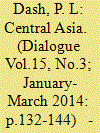

|
|
|
|
|
| Publication |
2014.
|
| Summary/Abstract |
In 2011-2012 all Central Asian countries have celebrated 20th year of their independence. They have achieved commendable progress in all spheres of their life during these years. Getting over from the monolithic ideology of communism, they have shifted to something that is not similar to any system. However, three areas are clearly discernible in the transition process of the last two decades: economy, society and ideology. The economy is no longer the command socialist economy. It is opening up, in some areas rapidly and in others slowly. Predominant private economic activities are visible in the market places. In laying the foundation of modern industry they are less visible. Foreign Direct Investment has been steadily flowing with varying degree of success in each country depending how investment savvy the FDI rules have been. The State has retained control over all spheres of economic activities. The society is no longer the communist one with free education and kindergarten, full employment guarantee to all, free housing, free medical care and many other benefits. All these have vanished. Everyone has to
fend for himself and his family. This is where it has created a schism between the haves and the have-nots thereby polarizing the society into rich and the poor. In the ideological realm, the Marxist-Leninist ideology has been completely given up. Even in academic libraries it is hard to find the works of Marx and Lenin that once adorned the shelves. Instead, works of incumbent presidents occupy the stacks. There is an irony: what the people wish to preserve, the presidents do not desire to protect.
|
|
|
|
|
|
|
|
|
|
|
|
|
|
|
|
| 2 |
ID:
129424
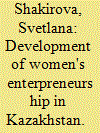

|
|
|
|
|
| Publication |
2014.
|
| Summary/Abstract |
The level of development of women's entrepreneurship is an eloquent indicator of the level of business development in Kazakhstan. Currently, women's contribution to GDP in Kazakhstan is 40 percent and the share of SMEs run by women is 41 percent. According to the Statistics Agency of Kazakhstan , the proportion of small and medium business in the country's GDP is 17.8 percent. It is expected that by 2020.
|
|
|
|
|
|
|
|
|
|
|
|
|
|
|
|
| 3 |
ID:
129411
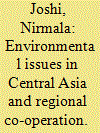

|
|
|
|
|
| Publication |
2014.
|
| Summary/Abstract |
Environmental security has become an integral component of human security. An ecological balance is essential for people to be able to lead a normal and a healthy life. Today the issue to lead a normal
life has acquired global significance and nations are discussing climate change, global warming and its likely impact on human beings, food security and biodiversity. In this regard the Central Asian States (CAS) are no exception. Since independence these States have been grappling with several issues of concerns to them. Among the environmental issues of Central Asia the most catastrophic one is the desiccation of the Aral Sea, which has now shrunk to dangerous proportions causing enormous socio-economic and health problems. At the crux of this issue is water and its inefficient management. Water management problems are also at the centre of regional politics and tensions. The Aral Sea basin encompasses all the CAS and Afghanistan. A solution to this grave problem has to be, therefore, found in a collective and a collaborative manner before it becomes worse. Is such a co-operation possible? The article examines the status of the Aral Sea and explores the possibility of a cooperative approach.
|
|
|
|
|
|
|
|
|
|
|
|
|
|
|
|
| 4 |
ID:
129430
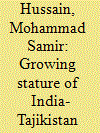

|
|
|
|
|
| Publication |
2014.
|
| Summary/Abstract |
'Tajikistan is a key partner of India in the Central Asian region' - Indian Prime Minister, Manmohan Singh, September 2012
The end of the Cold War, witnessed a dramatic transformation in the world order. India has concluded strategic partnership agreements with various regional and global partners such as the United States, Russia, France, Japan, Kazakhstan, Afghanistan, Uzbekistan etc. Tajikistan became the latest country to have concluded the strategic partnership agreement with India and the third among the Central Asian Republics (CARs) after Kazakhstan and Uzbekistan. The post-Cold War global strategic developments have brought India and Tajikistan closer to one another. Strategic partnership agreement makes a lot of sense when Tajikistan is considered India's gateway to Central Asia. Strategic partnership agreement is part of India's foreign policy goals to strengthen its presence in areas of interest to India and gaining
more strategic space. The agreement was signed during the visit of the President of the Republic of Tajikistan, Emomali Rahmon to India in September 2012. It was important in a way that it elevated the old close normal bilateral ties to strategic level. With this, both sides can now engage in a robust manner. The strategic importance of this partnership lies in sharing common perspectives on several international
and regional issues. In the 21st century, both sides would like to establish qualitatively new and mutually beneficial relations in the political, economic, military, development cooperation and in other areas.
|
|
|
|
|
|
|
|
|
|
|
|
|
|
|
|
| 5 |
ID:
129412


|
|
|
|
|
| Publication |
2014.
|
| Summary/Abstract |
Tensions around water distribution and consumption has assumed such proportions that experts have started talking about hydro-conflict and hydro-war in Central Asia . No other region in the world has faced such security peril linked to water. Crux of the matter is that water resources of the countries of
Central Asia are not distributed equitably. The region is clearly divided into water-rich States like Tajikistan and Kyrgyzstan on the one hand, and countries like Uzbekistan, Turkmenistan and Kazakhstan dependent on them for water, on the other. While Kirgyzstan controls the riverbasin of Syrdaria, Tajikistan controls water resources of Amudaria. Syrdaria is the longest and second largest in terms of water resources in Central Asia. Syrdaria with a length of 3019 km covers an area of 219 thousand square km. The major part, 75.2 percent of water resources of Syrdaria is formed in Kyrgyzstan, 15.25 percent on the territory of Uzbekistan, 6.9 percent in Kazakhstan and 2.7 percent in Tajikistan . Amudaria river has a length of 2540 km, with a basin of 309 square km. Like Syrdaria, Amudaria loses much of its water resources for irrigation purpose in the downstream. The major portion of water resources of Amudaria (74 percent) is formed on the territory of Tajikistan, while 13.9 percent of the water is formed in Afghanistan and Iran, and only 8.5 percent on the territory of Uzbekistan
|
|
|
|
|
|
|
|
|
|
|
|
|
|
|
|
| 6 |
ID:
129407
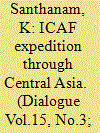

|
|
|
|
|
| Publication |
2014.
|
| Summary/Abstract |
In a global milieu where traditional interstate diplomacy is often forced to underplay critical dynamics such as the role of culture, education, entrepreneurship and tourism in bilateral ties, there is a need to establish other channels of communication and interactions between States. These are not seen as alternatives but as complementary modules for enhancing cooperation between States. The India Central Asia Foundation's (ICAF) expedition through Central Asia covering the three countries of Kazakhstan, Kyrgyz Republic and Uzbekistan qualifies as a worthy endeavour premised on this principle of Track II diplomacy. The driving expedition was organised by the ICAF during September 18 - October 05, 2013. The 16-member expedition covered 5700 km in three countries - Kazakhstan, Kyrgyz Republic and Uzbekistan in 18 days. The team brought various skills to the venture, from knowledge of the history of
the places to politics and economics. It included people who could speak the local languages. The members left New Delhi on September 18, 2013 by Air Astana and reached Astana via Almaty the same day at 21:30 hrs (Kazakhstan time). During the seven day expedition in Kazakhstan, the destinations covered were Astana, Karaganda, Balqash, Taldyqorgan, Jarkent, Khorgos (including Khorgos in Xinjiang province of China also) and Almaty. The next three days (Sept 25-27) were spent in Bishkek and Osh in the Kyrgyz Republic. We covered Andijon, Ferghana, Kokand, Tashkent, Samarkand, Bukhara, Khiva (Khwarizm) and Urgench in Uzbekistan during the next 8 days.
|
|
|
|
|
|
|
|
|
|
|
|
|
|
|
|
| 7 |
ID:
129400
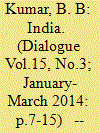

|
|
|
|
|
| Publication |
2014.
|
| Summary/Abstract |
When one hears about the sad demise of a life just beginning to bloom, and yet another made dead while living by robbing her childhood and future dreams, both displaying extreme beastliness. The shock and surprise which the nation experiences, knows no bound. Usually such sad happenings are followed by angry protests, rallies, dharnas and bandhs, which is quite natural. Recent incidents, which have shocked the nation, are the murder of a young, just 19 year old, boy and the rape of a 13 year old girl in the capital city of this unfortunate country. The boy, Nido Tania, was from Arunachal Pradesh and the girl from Manipur. The question is: how long this nation of 120 crore people shall tolerate the beastliness of say, a few thousand goondas? And again, why such heinous acts of murder and rape continue to recur even after repeated resolve, at the highest level, to control the deviants?
|
|
|
|
|
|
|
|
|
|
|
|
|
|
|
|
| 8 |
ID:
129420


|
|
|
|
|
| Publication |
2014.
|
| Summary/Abstract |
For nearly two decades, the representatives of the official authorities as well as public and private business entities from both Kazakhstani and Indian sides used to talk about the possibility and even the necessity of trade in strategically important types of raw products, including uranium. However, despite throughout the whole of this period, basic goods constitute the lion's share of Kazakhstan's exports to India, but bilateral trade in uranium still remains open to question. An old saying goes: 'The more you know your counterpart, the easier it is for you to deal with him', which is crucially applied to India and Kazakhstan suffering from the lack of mutual awareness. In this regard, it seems quite important to outline main economic, legislative and other aspects related to the uranium industry in Kazakhstan.
|
|
|
|
|
|
|
|
|
|
|
|
|
|
|
|
| 9 |
ID:
129404
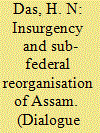

|
|
|
|
|
| Publication |
2014.
|
| Summary/Abstract |
From the beginning of human existence people have moved in groups in search of food and also for ensuring security. Groups have expanded into ethnic communities with separate identities, then into races and ultimately into nations. People have come to distinguish themselves by the colour of their skins; the different languages they speak, faith, religion or regions they inhabited. As civilization advanced, people
became more attached to one community or another. Particular territories were carved out as the habitat of particular communities or races. Even within universal empires sub-divisions became discernible. Sometimes racial conflicts arose. The imperial powers had to intervene and mediate in such disputes
|
|
|
|
|
|
|
|
|
|
|
|
|
|
|
|
| 10 |
ID:
129401
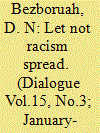

|
|
|
|
|
| Publication |
2014.
|
| Summary/Abstract |
On January 29 this year, Nido Tania, a 19-year-old student from Arunachal Pradesh studying in Delhi was beaten up with iron rods by some traders of Lajpat Nagar after an altercation with a shopkeeper who had made fun of the young student's hairstyle. The post-mortem report shows that his death was caused by severe head and lung injuries. The police have arrested six people whose bail applications have been
turned down. Considering the crime rate in Delhi, this would probably have been written off as just one of those things. After all, India's capital city is witness to several murders, rapes and robberies every day. However, the brutal killing of Nido Tania cannot be dismissed as just one of those things simply because one cannot run away from the fact that he was killed because of the accident of his birth-because someone from Arunachal Pradesh did not look like someone of his age from mainland India. And yet there could be no question of denying his Indian nationality and citizenship.
|
|
|
|
|
|
|
|
|
|
|
|
|
|
|
|
| 11 |
ID:
129409


|
|
|
|
|
| Publication |
2014.
|
| Summary/Abstract |
Let me frankly admit that reminiscences about one of those sultry, summer evenings in India drove this author once to hark back to the year 2013, when a television show was on in Tashkent. The programme
was too interesting to take away eyes from it. It was a special programme devoted to the life and work of Amrita Pritam - one of India's most celebrated poets and writers. Pritam is no more; but her immortal works are very much vivid in Indian minds was evidenced by the television show. It reminded me of the last meeting I had with this great Indian personality at the fag end of the year when 1996 was bidding adieu to the world. It was at her home in Delhi. It was an extremely friendly ambience in the evening and I do vividly remember the interesting discussions we had together along with her family members. In that
memorable evening we talked about various aspects of Indo-Uzbek relations, particularly in the fields of culture, literature and people to people contacts between India and Uzbekistan.
|
|
|
|
|
|
|
|
|
|
|
|
|
|
|
|
| 12 |
ID:
129402
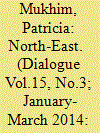

|
|
|
|
|
| Publication |
2014.
|
| Summary/Abstract |
At a time when the discourse among North-Easterners in Delhi is centred around the death of Nido Tania, a student from Arunachal Pradesh, and sharp remarks of racism are flying thick and fast, a central government limping on its last legs has responded with a typical knee jerk reaction by setting up a Committee to look into this so called 'racial prejudice' that visits people from the region regularly like the measles. The Committee comprises an all-male team of retired bureaucrats as if all the wisdom about social and racial prejudices resides with them. That the Home Ministry could notify those names of people of privilege who have never walked in the shoes of the ordinary North- Easterner shopping in the crowded sabzi mandi of Delhi is scandalous. In retrospect this seems like an attempt to quickly shut up the protests and assuage the anger of the people of the region studying, working or living in Delhi.
|
|
|
|
|
|
|
|
|
|
|
|
|
|
|
|
| 13 |
ID:
129408
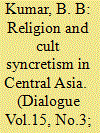

|
|
|
|
|
| Publication |
2014.
|
| Summary/Abstract |
The famous Nicolo seal with a four-armed deity, having in his four hands a wheel, a mace, a ring like object and a globular thing, with a devotee standing by his side in respectful pose with folded hands, was
described by Cunningham in the Numismatic Chronicle as Vishnu, the deity and King Huvishka, the attending devotee. The Kushana identity of Huvishka was identified because of the affinities of headdress and garment.1 Right interpretation of the seal, however, was possible only after correct decipherment of the inscription by R. Ghirsman.2 The inscription, according to him, was in Tokharian script and in Tokharian language; it contained the names of Mihir (the Sun God), Vishnu and Shiva. But the devotee, according to him, was some unknown Hapthalite Chief, rather than the Kushana King Huvishka. Any way, irrespective of the identity of the devotee, the use of Tokharian script and language made it clear that composite cult of Shiva (Siva), Vishnu (Visnu) and Mitra was popular in Central Asia.
|
|
|
|
|
|
|
|
|
|
|
|
|
|
|
|
| 14 |
ID:
129432


|
|
|
|
|
| Publication |
2014.
|
| Summary/Abstract |
Tenancy reform has long remained an unfinished agenda in Indian agriculture. Although, all the States passed their respective tenancy legislations after independence, except for a few States like West Bengal,
most of the States have failed in achieving their goals of efficient and equitable use of agricultural land. This has been recognised in the Draft National Land Reform Policy (DNLRP) which was put in public
domain for discussion purposes and comments on 24th July, 2013 by the Department of Land Resources, Ministry of Rural Development, Government of India. Though the issue of tenancy reform was almost
relegated to the history, at least in the policy arena, the DNLRP has again enthused some interest on the issue. In light of the DNLRP, the present paper revisits the long pending issue of tenancy reforms in India.The draft of NLRP contains 18 chapters excluding the introduction. Each of the chapters deals with a critical issue. Some of the major issues that the DNLRP dealt with, among others, are i) protection of
lands belonging to Schedule Castes, Schedule Tribes and other Marginalised Communities, ii) Land Rights to Women, iii) Tenancy and iv) Modernization of land records. Chapter 10 of the DNLRP
presents the recommendations related to tenancy.
|
|
|
|
|
|
|
|
|
|
|
|
|
|
|
|
| 15 |
ID:
129406
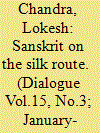

|
|
|
|
|
| Publication |
2014.
|
| Summary/Abstract |
Sanskrit was the mind of Sill: Route, at one with the sky-void and the spring mist, the live hues of sensibility dyed in eternity. a bridge of dreams floating across eloudless skies of the sands, a symbol system that made the heart pure, the spring blossoms of the devout. It was the realisation of Truth, and the very being of Values. Sanskrit was to enter the profound, the inner depths. Today. torn Sanskrit fragments
from the silk Route reflect the savagery of fundamentalism. the furious wrath of apostasy. They remind me of ten million Buddhist Sutras being mthessly committed to fire in Buryatia. Mongolia. Kalrnykia.
and Tuva. As Lama Sandaa related to me with tears ?owing across his withered face of eithty years: 'I was forced to destroy what I revered, admired and had faith in. There's no torture more terrible than that'.
Likewise. these Sanskrit fragments are tears of time. Scholars sit in their silence, forgetting the hours that follow each either, to identify tiny and large feagments as if perfecting a diamond. They are ratnaktita or heaps of jewels in the words of Prof. Karashima. We are pilgrims to amazing centuries that have ?ourished and vanished.Vedic Shaivism
|
|
|
|
|
|
|
|
|
|
|
|
|
|
|
|
| 16 |
ID:
129423
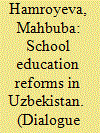

|
|
|
|
|
| Publication |
2014.
|
| Summary/Abstract |
After gaining independence, Uzbekistan created favourable conditions for development of education. Legal framework for working out a national education policy was the imperative of the day. Only on the
basis of a strong cadre policy could the country look forward to development and choose its own path. Adoption of the Constitution of the Republic of Uzbekistan was the first step in this direction that guaranteed all citizens the right to education. It provided that the State shall guarantee free secondary education to all children. Schooling is under the State control.1 Subsequent reforms were undertaken in a
phased manner and these reforms have helped in improving the structure and content of education. This paper deals exclusively with the school education at a time when the country transited from decadent Soviet system to a new system of school education.
|
|
|
|
|
|
|
|
|
|
|
|
|
|
|
|
| 17 |
ID:
129410
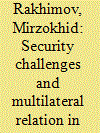

|
|
|
|
|
| Publication |
2014.
|
| Summary/Abstract |
New geopolitics and security Central Asia faced considerable political, social, and cultural changes throughout the whole of the 20th century; since the beginning of the 21st century, the region is confronted to new steps of the geopolitical transformation. Some experts say that Central Asia is returning to the Great Game of the 19th century but with new players. It is well-known that Central Asia historically was in the center or important aspects of interest of different empires and one could say that the region was more or less in Great Game situation during all periods of its history. After the collapse of the Soviet Union, the newly Independent Central Asian republics tried to form new bilateral and multilateral relations and within a short time the Central Asian nations were formally recognized by many countries, which established with most of them diplomatic ties and exchanged diplomatic missions. The region's countries have joined the main international and regional organizations.
|
|
|
|
|
|
|
|
|
|
|
|
|
|
|
|
| 18 |
ID:
129427
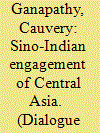

|
|
|
|
|
| Publication |
2014.
|
| Summary/Abstract |
In the Sino-Indian dynamic, there are several theatres of play - thematic and geographic. One such crucible in this competition is the Central Asian space. There is much Indian diplomacy could learn from the Chinese pursuit of Central Asia. There is, however, also many allowances that those scrutinising India's position in Central Asia need to make before announcing their final verdict on the subject. The compulsions of a formalised structure of education, often trumps the catholicity in the pursuit of knowledge. So attuned does the understanding of an area become to the straightjacketed contours of
the academic training imbibed, that it threatens a rightful appreciation of the myriad variables which define a subject. The study of India's relations with Central Asia has variously been the interest of academics who study it through the prism of a singular domain of expertise - economic, political, social, anthropological, and historical, among others. Such focused attention undoubtedly ensures a level of expertise that a multidisciplinary approach cannot guarantee; and yet, it is perhaps equally true that it is well-nigh impossible to gauge the value of India's engagement with the Central Asian States on the basis of a single discipline. An almost natural tendency to do this portrays India's Central Asian story as abysmal when compared with China's. Such a narrative overlooks the possibility that China and India's stakes in the Central Asian region are far from being equal, much less the same.
|
|
|
|
|
|
|
|
|
|
|
|
|
|
|
|
| 19 |
ID:
129405


|
|
|
|
|
| Publication |
2014.
|
| Summary/Abstract |
Shiva as the Supreme Reality of Being-Consciousness-Bliss (Sacchidananda) represents the great Unknown beyond the senses, speech, and mind. This formless reality cannot be reduced to any particular historical depiction, description, or nomenclature. Shiva in Sanskrit is not a name but a description of that which is auspicious, indicating something beyond words. One needs a deeper vision to understand the Supreme Reality that both contains and transcends all things, and is beyond speech and mind. The vision of the Supreme Shiva takes us beyond all dualities and contradictions, and remains forever a matter of paradox and mystery that cannot be reduced to any linear time-space coordinates such as characterizes physical reality. Even quantum physics, with its ability to deconstruct time and space realities, is just beginning to approach or to emulate the language of Shiva.
|
|
|
|
|
|
|
|
|
|
|
|
|
|
|
|
| 20 |
ID:
129413


|
|
|
|
|
| Publication |
2014.
|
| Summary/Abstract |
The problem of water supply and share of trans-boundary water resources today are particularly acute in Central Asia. Disruption of earlier economic relations between the former Soviet republics of Central
Asia led to widespread drop in production and reduced production of energy resources. Streamlined operation of reservoirs and delivery systems of energy resources began to falter. Central Asian States are
faced with the problem of the joint use of water resources in the region, which in the past were controlled from a single centre, Moscow. Changes in the political and economic situation in the region led to the sovereign States using water resources, primarily in their own national interest1. Water resources in Central Asia have always had and continue to have a significant impact on economic activities of the region, as all major rivers are trans-border i.e. cross the territory of two or more countries. Any change in water use by one of the countries that share common water ecosystems, or impact on water-course through construction of water facilities will inevitably affect the interests of others. Moreover, the lack of coordination can lead to a conflict, because the effects are often unfavourable for downstream countries, both for economic development and socio-environmental conditions.
|
|
|
|
|
|
|
|
|
|
|
|
|
|
|
|
|
|
|
|
|